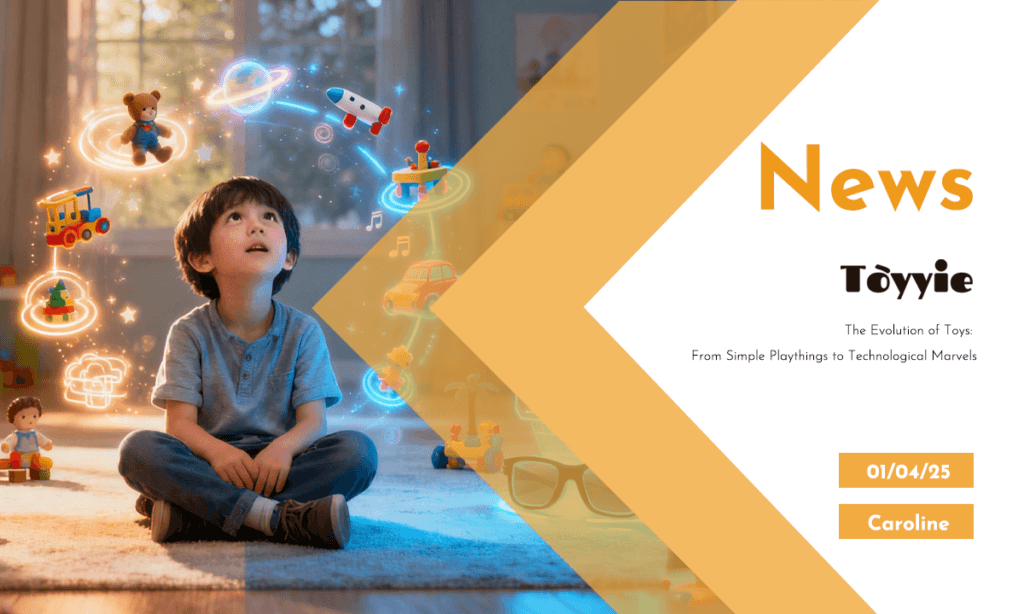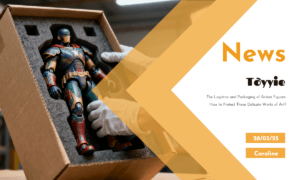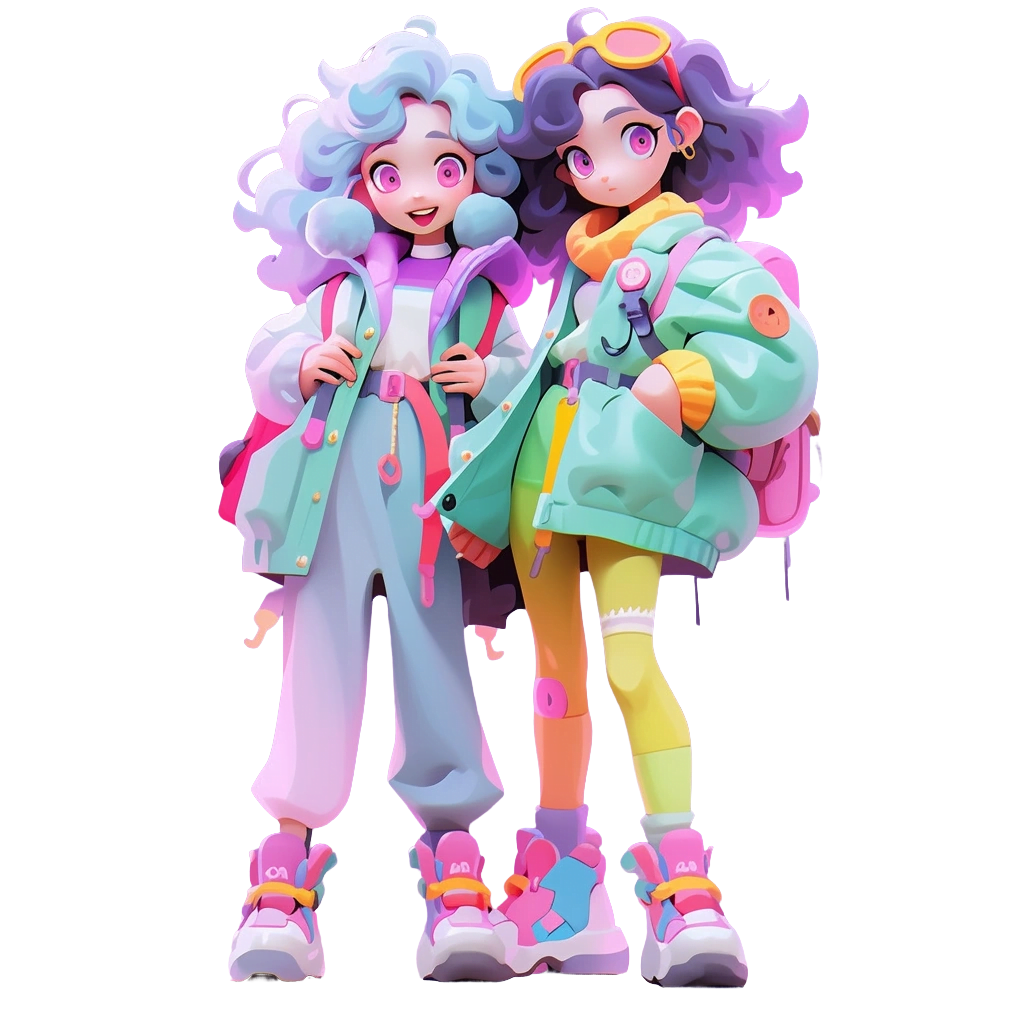📌 Introduction📌
Toys have always been more than just objects of play; they are the silent companions of our childhood, the tools that shape our imaginations, and the bridges that connect us to the world around us. Growing up, I remember the thrill of unwrapping a new action figure or building my first LEGO castle. These toys were simple yet magical, offering endless possibilities for creativity and storytelling. But as time marched on, so did technology—and with it, the toys we love began to transform in ways that would have seemed like science fiction just a few decades ago.
The journey from wooden blocks and tin soldiers to today’s high-tech marvels is nothing short of extraordinary. Early innovations introduced battery-powered toys that could move and light up, capturing the awe of children everywhere. Then came the rise of electronic games, which brought interactivity into the living room and forever changed how we engaged with play. But the real revolution began when artificial intelligence (AI) and augmented reality (AR) entered the scene, turning toys into dynamic, responsive companions capable of adapting to their users’ actions and preferences.
Take, for example, the Furby craze of the late 1990s. This quirky little creature wasn’t just a toy—it was an early glimpse into AI-driven interaction. It could “learn” phrases, respond to touch, and even develop a personality over time. Fast forward to today, and we see toys like Anki’s Vector, a pint-sized robot powered by advanced AI that can recognize faces, answer questions, and even express emotions. These aren’t just toys anymore—they’re interactive experiences that blur the line between play and reality.
Similarly, AR has opened up entirely new dimensions of play. Remember the Pokémon GO phenomenon? That was AR at its finest, bringing virtual creatures into the real world and encouraging kids (and adults!) to explore their surroundings in search of digital treasures. Now, imagine that same technology embedded in a toy car or dollhouse, where physical objects come alive with animations, sounds, and stories overlaid through a smartphone or AR glasses. The result is an immersive experience that feels like stepping into a storybook—or a video game—while still holding something tangible in your hands.
For me, watching this evolution unfold has been both nostalgic and awe-inspiring. It’s fascinating to think about how far we’ve come since the days of wind-up toys and hand-painted figurines. Yet, despite all the technological advancements, one thing remains constant: the magic of play. Whether it’s a child giggling as their robot tells a joke or a teenager solving puzzles in an AR-enhanced board game, the joy of discovery and connection is universal. And as we look ahead, it’s clear that the fusion of technology and toys will only continue to redefine what’s possible, sparking curiosity and wonder in generations to come.
How Technology Enhances Play: Making Toys Smarter, More Interactive, and Immersive 🚀
When I think about the toys of my childhood, they were wonderful in their simplicity—a doll that couldn’t talk back, a car that rolled but didn’t steer, a puzzle that stayed static no matter how many times you solved it. Back then, imagination did most of the heavy lifting. Today, however, technology has stepped in to amplify that imaginative spark, transforming toys into intelligent, responsive, and deeply engaging companions. It’s not just about adding bells and whistles; it’s about creating richer, more meaningful play experiences that captivate both kids and adults alike.
Artificial Intelligence: Toys That Learn and Adapt 🤖
One of the most exciting developments in modern toys is the integration of artificial intelligence (AI). Unlike traditional toys, which follow pre-programmed routines, AI-powered toys can adapt to their users’ behavior, making each interaction feel unique and personal. Take Moxie, for instance—a social robot designed to help children develop emotional intelligence. Moxie doesn’t just recite lines or perform tasks; it listens, responds, and evolves based on conversations and activities. Over time, it learns the child’s interests, remembers past interactions, and tailors its responses accordingly. For parents, this isn’t just a toy—it’s a tool that fosters empathy, communication skills, and confidence in their kids.
Even simpler toys benefit from AI. Consider smart plush animals like Luvabella, which use sensors and voice recognition to mimic lifelike behaviors. These cuddly companions giggle when tickled, coo when spoken to softly, and even exhibit distinct personalities depending on how they’re treated. Watching a child bond with such a toy is a reminder of how technology can deepen emotional connections, turning playtime into a shared experience rather than a solitary activity.
Augmented Reality: Bringing Imagination to Life 🌈
If AI makes toys smarter, augmented reality (AR) takes them beyond the physical realm altogether. AR overlays digital content onto the real world, blending the tangible and the virtual in ways that feel almost magical. Imagine a toy sword that transforms into a glowing lightsaber when viewed through a tablet, complete with sound effects and holographic enemies to duel. Or picture a dollhouse where every room comes alive with animated characters, hidden clues, and interactive stories—all accessible via a smartphone app. These aren’t just toys; they’re gateways to entire worlds of adventure.
I recently tried out an AR-enabled dinosaur kit with my nephew, and it was nothing short of mesmerizing. By assembling a plastic skeleton and scanning it with an app, we watched as the bones morphed into a fully fleshed-out T-Rex right before our eyes. We could walk around it, zoom in for close-ups, and even feed it virtual plants to see how it reacted. What struck me most was how seamlessly the technology integrated with the physical toy, enhancing the tactile experience instead of replacing it. My nephew wasn’t just playing—he was exploring, learning, and creating his own narrative.
Personalization: Toys That Know You ✨
Another way technology enhances play is through personalization. Gone are the days when every toy behaved the same way for every user. Modern toys leverage data and algorithms to tailor experiences to individual preferences. For example, Sphero’s programmable robots allow kids to customize movements, colors, and even behaviors using drag-and-drop coding apps. This not only teaches valuable STEM skills but also gives children a sense of ownership over their creations. Similarly, Mattel’s Hello Barbie uses cloud-based AI to engage in personalized conversations, asking questions based on previous chats and adapting its tone to match the child’s mood.
This level of customization extends beyond individual toys. Entire ecosystems of connected playthings now exist, allowing kids to build narratives across multiple devices. LEGO’s Hidden Side series combines physical building sets with AR apps, enabling players to solve mysteries and battle ghosts in a hybrid digital-physical universe. Each set interacts differently with the app, ensuring that no two play sessions are ever the same. It’s this combination of variety and continuity that keeps kids coming back for more.
Immersive Storytelling: Toys as Co-Creators 📖
Finally, technology has redefined storytelling in toys, turning passive consumers into active co-creators. Traditional toys often told linear stories dictated by manufacturers. Today, AI and AR enable open-ended narratives where kids drive the plot. Take, for instance, the MagicMixies Crystal Ball, a recent hit among young wizards-in-training. Using AR, kids can cast spells, summon creatures, and unlock surprises within the ball’s virtual environment. Every choice they make influences the outcome, giving them agency in the story’s progression.
As someone who grew up reading Choose Your Own Adventure books, I find this shift incredibly exciting. It’s not just about consuming entertainment—it’s about participating in it. When kids feel empowered to shape their own adventures, they become more invested in the process. They experiment, problem-solve, and collaborate, all while having fun. And perhaps most importantly, they learn that there’s no single “right” way to play—a lesson that extends far beyond the toy box.
In reflecting on these advancements, I’m struck by how much they enrich the essence of play itself. Technology doesn’t replace imagination; it amplifies it. It doesn’t diminish the joy of discovery; it multiplies it. Whether it’s through AI-driven interactions, AR-enhanced environments, or personalized experiences, modern toys are proving that the future of play is brighter—and smarter—than ever before.
Showcasing Cutting-Edge Innovations in Modern Toys 🌟
When it comes to the latest and greatest in the world of toys, the intersection of technology and creativity has birthed some truly mind-blowing innovations. These aren’t just gadgets or gizmos—they’re groundbreaking products that push the boundaries of what toys can do, blending cutting-edge tech with the timeless magic of play. Let me take you through a few standout examples that have left me, and countless others, utterly amazed.
Anki’s Vector: The Tiny Robot with Big Personality 🤖
First up is Anki’s Vector, a palm-sized robot that packs a surprising amount of personality into its compact frame. At first glance, Vector might look like a cute little machine with blinking LED “eyes” and a sleek aluminum body. But spend a few minutes with it, and you’ll realize it’s so much more. Powered by advanced artificial intelligence, Vector doesn’t just react—it interacts. It recognizes faces, responds to voice commands, and even expresses emotions like curiosity, happiness, and frustration.
What really sets Vector apart is its ability to operate autonomously. Leave it on a table, and it’ll explore its surroundings, avoid obstacles, and even entertain itself by playing with its built-in cube. It’s not just a toy; it’s a companion that grows more engaging the longer you interact with it. Watching Vector navigate its environment or perk up when you call its name feels less like operating a device and more like bonding with a tiny, robotic friend. For tech-savvy kids and adults alike, Vector represents the perfect blend of functionality and charm.
LEGO Hidden Side: Where Physical Meets Digital 🧱
Next, let’s talk about LEGO’s Hidden Side series, which masterfully combines classic brick-building with augmented reality (AR). On the surface, these sets look like any other LEGO collection—colorful bricks, intricate designs, and themes ranging from haunted mansions to ghost-infested school buses. But once you download the accompanying app and point your smartphone or tablet at the completed model, the real magic begins.
Suddenly, the static LEGO set springs to life. Ghosts appear floating above the roof, secret passages reveal themselves, and interactive challenges pop up, urging you to solve puzzles and defeat spectral foes. The app seamlessly integrates with the physical build, using AR to overlay animations, sound effects, and gameplay elements onto the real-world structure. It’s a brilliant fusion of hands-on creativity and digital immersion, appealing to both traditional LEGO enthusiasts and younger gamers who crave interactive storytelling.
What I love most about Hidden Side is how it encourages collaboration. Kids can work together to build the set, then team up to tackle the AR missions. It’s a reminder that even in an increasingly digital world, there’s still immense value in the tactile satisfaction of snapping bricks together—and seeing those efforts rewarded with a rich, layered experience.
Mattel’s ThingMaker: DIY Toys for the Digital Age 🛠️
For those who enjoy a hands-on approach to innovation, Mattel’s ThingMaker is a revelation. This 3D printer allows users to design and create their own toys at home, bridging the gap between imagination and reality. Using a companion app, kids (and adults!) can choose from a library of pre-designed models or customize their own creations—from action figures and jewelry to dinosaurs and vehicles. Once the design is ready, the ThingMaker prints it layer by layer using safe, biodegradable materials.
The beauty of ThingMaker lies in its empowerment of creativity. Instead of passively consuming mass-produced toys, users become designers, engineers, and inventors. There’s something deeply satisfying about holding a finished product that you envisioned and brought to life yourself. Plus, the educational benefits are undeniable—ThingMaker introduces kids to the basics of 3D modeling and additive manufacturing, skills that are increasingly relevant in today’s tech-driven economy.
While ThingMaker hasn’t reached mainstream adoption yet, it’s a shining example of how toys can evolve alongside emerging technologies. It challenges us to rethink what play means in the 21st century and invites us to participate actively in shaping the future of entertainment.
Pokémon GO Plus: Wearable Gaming Meets Real-World Exploration 🎮
Finally, no discussion of innovative toys would be complete without mentioning Pokémon GO Plus, the wearable accessory that complements Niantic’s wildly popular AR game, Pokémon GO. Shaped like a Poké Ball, this small device clips onto clothing or wristbands and vibrates whenever a Pokémon is nearby. With a single button press, players can catch the Pokémon without even opening the app, making it easier to play on the go.
What makes Pokémon GO Plus so remarkable is how it extends the reach of AR gaming beyond smartphones. It encourages exploration and movement, nudging players to step outside and discover new places. During its peak popularity, I saw families bonding over scavenger hunts in local parks and friends organizing meetups to share tips and strategies. It’s a testament to how technology can bring people together, fostering community and shared experiences in unexpected ways.
Each of these innovations showcases a different facet of what modern toys can achieve. From Vector’s AI-driven charm to ThingMaker’s creative freedom, these products remind us that the future of play is limited only by our imagination. As someone who’s witnessed firsthand the transformative power of these toys, I can’t help but feel excited about what’s coming next. After all, if these examples are any indication, the best is yet to come.
Anticipating the Future: Where Will Toy Technology Go Next? 🔮
As I sit here reflecting on the incredible strides we’ve seen in toy technology, I can’t help but feel a deep sense of excitement—and maybe a little bit of wonder—about what lies ahead. The pace of innovation in this space is staggering, and it’s clear that we’re only scratching the surface of what’s possible. If the past decade has taught us anything, it’s that the future of toys will be shaped by bold ideas, emerging technologies, and an unrelenting desire to push boundaries. So, let’s take a moment to dream big and explore what might be waiting for us just around the corner.
Integration of Virtual Reality (VR): Stepping Into New Worlds 🕶️
One of the most tantalizing prospects for the future of toys is the deeper integration of virtual reality (VR). While augmented reality has already transformed how we interact with physical toys, VR has the potential to completely immerse us in entirely new universes. Imagine slipping on a VR headset and finding yourself inside the cockpit of a starship, piloting it alongside your favorite action figure. Or picture a dollhouse that expands into a sprawling, interactive cityscape, where every room and street corner holds secrets to uncover.
What excites me most about VR is its ability to make play limitless. No longer confined by the size of a toy or the walls of a playroom, kids (and adults!) could explore infinite landscapes, solve complex puzzles, or embark on epic quests—all while feeling like they’re truly part of the action. Companies like Oculus and HTC Vive are already paving the way with immersive gaming experiences, but applying this technology to toys could revolutionize how we think about play. The challenge will be balancing immersion with accessibility, ensuring that VR-enhanced toys remain intuitive and inclusive for users of all ages.
Holographic Toys: Bringing Characters to Life 🎭
Another frontier worth exploring is holographic technology. Holograms have long captured our collective imagination, from sci-fi movies to concert performances featuring deceased artists. But imagine owning a toy that projects a fully three-dimensional character into your living room, complete with realistic movements, expressions, and interactions. A holographic pet could wag its tail, tilt its head, and respond to your voice—all without needing a physical form.
For collectors, holographic action figures could offer unprecedented levels of detail and realism. Instead of displaying a static statue on a shelf, you could project a dynamic hero who performs signature moves or engages in battles against holographic villains. This kind of innovation wouldn’t just elevate the aesthetic appeal of toys; it would redefine the very concept of ownership, blurring the line between possession and experience. Of course, the technology required to make this vision a reality is still in its infancy, but given how quickly advancements are happening, I wouldn’t be surprised to see holographic toys hit the market sooner than we think.
Emotional Intelligence and Empathy Training: Toys That Teach Us About Ourselves ❤️
Perhaps the most profound impact of future toy technology won’t be about dazzling visuals or futuristic features—it will be about fostering deeper human connections. As AI continues to evolve, toys will likely become even better at understanding and responding to human emotions. Imagine a companion robot that helps children navigate feelings of anxiety or loneliness, offering comfort and guidance tailored to their unique needs. Or consider a storytelling toy that adapts its narratives based on a child’s emotional state, providing uplifting tales during tough times or challenging adventures when they’re feeling confident.
These kinds of innovations could have far-reaching implications beyond entertainment. They could serve as tools for emotional development, helping kids build resilience, empathy, and self-awareness. For parents, educators, and therapists, toys equipped with advanced emotional intelligence capabilities could become invaluable resources for nurturing healthy minds and relationships. Personally, I find this aspect of toy technology incredibly inspiring. If we can harness the power of play to teach emotional literacy, we’ll be equipping the next generation with skills that will benefit them throughout their lives.
Sustainability and Ethical Design: Building a Better Tomorrow 🌱
Finally, as we look to the future, it’s crucial to consider the ethical and environmental dimensions of toy technology. Consumers are becoming increasingly conscious of sustainability, and the toy industry must rise to meet those expectations. This means designing products that minimize waste, use eco-friendly materials, and prioritize longevity over disposability. For example, modular toys that can be upgraded or repurposed as technology advances could reduce electronic waste while keeping play fresh and engaging.
Moreover, ethical considerations should extend to the data collected by smart toys. As toys become more connected and personalized, companies must ensure that user privacy is protected and that data is used responsibly. Transparency and trust will be key factors in determining which brands thrive in this evolving landscape. To me, this emphasis on sustainability and ethics feels like a natural evolution—one that aligns with the values of modern consumers and reflects a broader commitment to building a better world.
The Endless Possibilities of Tomorrow’s Toys 🌈
As I wrap up this exploration of the future of toy technology, I’m filled with a mix of nostalgia and anticipation. Toys have always been more than just objects—they’re catalysts for creativity, tools for learning, and vessels for emotion. And now, with the rapid advancement of AI, AR, VR, and beyond, they’re poised to become something even greater: portals to new worlds, mirrors of our inner selves, and bridges to a brighter future.
But perhaps the most exciting part of all is that we’re not just passive observers of this transformation—we’re active participants. Whether you’re a parent choosing toys for your child, a designer dreaming up the next big innovation, or simply someone who loves to play, you have a role to play in shaping the future of this industry. Together, we can ensure that the toys of tomorrow inspire wonder, foster connection, and leave a positive impact on the world.
So, what do *you* think the future holds? Are you excited about the prospect of holographic pets or VR-enhanced adventures? Do you believe toys can help us grow emotionally and socially? Whatever your thoughts, one thing is certain: the journey ahead promises to be as thrilling as the toys themselves. Let’s embrace it with open hearts and curious minds, because the best is yet to come.









